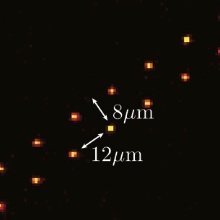Researchers from the University of Stuttgart and from the Institut d’Optique in Palaiseau have explored a unique state of matter, a so-called topological phase. Such a topological phase is the ground state of a quantum many-body system and exhibits unique properties. The collaboration between the group of Prof. Hans Peter Büchler in Stuttgart and the group of Prof. Antoine Browaeys in Palaiseau have for the first time observed such a phase in a quantum simulator, where the state of matter is realised in a well controlled environment and allows for the study of the unique properties. The research paves the way for future application in quantum technology of these unique properties. The research results are published in 1st August in Science as first release.
Most states of matter are characterized by the concept of spontaneous symmetry breaking, e.g., the periodic arrangement of atoms in a solid breaks the translational symmetry, or Ferromagnets with all the magnetic moments pointing into the same direction break the rotational symmetry. However, not all states of matter fall into this paradigm, and especially so-called topological phases cannot be characterized by a broken symmetry. Examples in condensed matter are the integer as well as the fractional quantum Hall state, and topological insulators.
In the present publication, such a topological phase was realized in artificial matter consisting of up to 14 individually trapped atoms excited into Rydberg states. The strong interaction between the Rydberg states gives rise to a quantum many-body system, whose ground state is determined by a topological phase. Due to the high control in such an artificial setup over the individual atoms, the unique properties of the topological phase could be directly probed and observed such as the existence of robust edge states, a characteristic gapped excitation spectrum, as well as the appearance of a string order parameter. The experimental observations performed within the group of Prof. Antoine Browaeys in Palaiseau are in excellent agreement with the theoretical expectations analyzed by the group of Prof. Hans Peter Büchler in Stuttgart.
Hans Peter Büchler is professor in theoretical physics and head of the institute for theoretical physics III at the University of Stuttgart. This research on quantum many-body systems in artificial matter and the realization of topological phases is funded by the European Research Council within the ERC project SIRPOL. Furthermore, this research question is also part of the EU flagship on quantum technologies under the aspect of quantum simulators. The research is performed within a strong collaboration between the theoretical group at the University of Stuttgart and the experimental group lead by Prof. Antoine Browaeys at the Institut d’optique in Palaiseau.
The research results are published in 1stAugust in Science online as first release:


